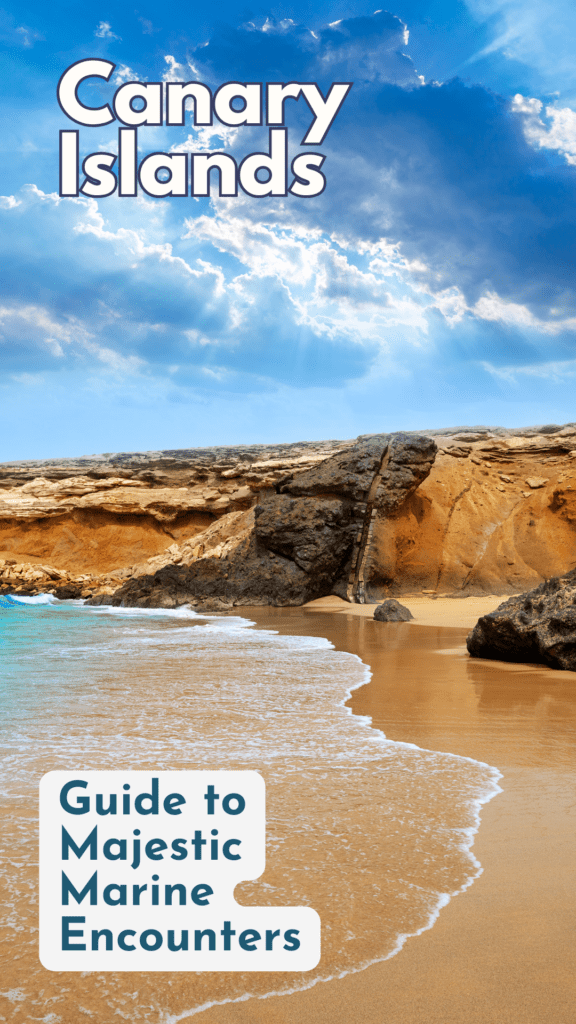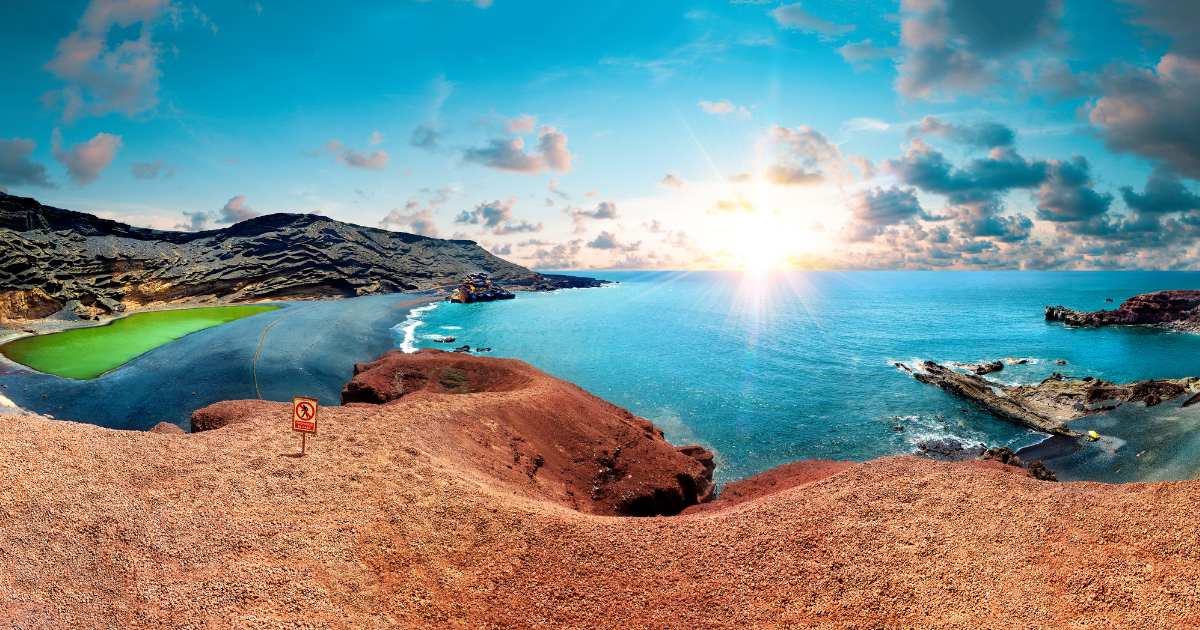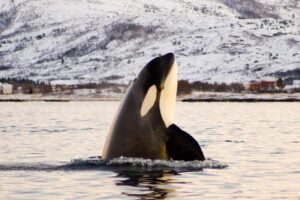Canary Islands Whale Watching: A Guide to Majestic Marine Encounters
Embarking on a whale watching tour in the Canary Islands offers you a maritime adventure set against the backdrop of the area’s stunning natural beauty. The archipelago’s warm, transparent waters are a prime habitat for a variety of marine life, including numerous species of whales and dolphins, which are drawn to the region’s rich seabeds. In fact, the islands are one of the few places on earth with resident populations of these magnificent creatures, meaning sightings are possible year-round, rather than being restricted to migratory seasons.


As you set sail from the islands’ coasts, you may find yourself in the company of playful dolphins and majestic pilot whales, both of which are common residents of these subtropical waters. The Canary Islands are recognized as a special area for whale and dolphin watching, due to the presence of up to 30 different species, making the experience both unique and diverse. The temperate climate of the islands ensures that these excursions are comfortable, and the expertise of local guides enhances your chances of memorable encounters.
Whale watching here is not just about the thrill of sightings, it’s also an educational experience that raises awareness of marine conservation. Tours are designed to be ecologically responsible and adhere to guidelines that protect the animals while still providing you with an intimate view of their world. When booking your trip, it’s recommended you choose an operator that demonstrates respect for these creatures and the marine environment, ensuring your adventure into the oceanic wild is both responsible and conscientious.
The Importance of Whale Watching in the Canary Islands
When you consider the breathtaking natural habitats of the ocean, the Canary Islands are a jewel worth exploring, particularly for the experience of whale watching. With more than a third of cetacean species gliding through these waters either as residents or while migrating, the significance of this activity to the region cannot be understated.
The archipelago is a thriving hotspot for marine life, attracting enthusiasts and scientists alike. Your encounters not only bring you closer to understanding marine species but also play a critical role in promoting eco-friendly tourism. This sustainable approach to experiencing nature ensures that the diverse biodiversity of the Canary Islands is appreciated and preserved.
Whale watching contributes substantially to the economy, catalyzing a symbiotic relationship between tourists and the islands. This benefit is two-fold; while bolstering tourism, it also funds conservation efforts. Remember that by choosing responsible tour operators—those who respect the creatures and their habitats—you’re supporting a model that prioritizes the welfare of these magnificent marine dwellers.
| Pros of Whale Watching | Description |
|---|---|
| Economic Growth | Boosts local economy through tourism. |
| Education & Awareness | Increases understanding of marine species and their habitats. |
| Environmental Conservation | Encourages eco-friendly practices and helps protect biodiversity. |
When you embark on a whale watching adventure in the Canary Islands, you are witnessing more than just wildlife—you are participating in a conservation-centered activity integral to the islands’ identity and future.
Types of Whales and Dolphins You Can See
When you embark on a whale or dolphin watching adventure in the Canary Islands, you are entering a world where a remarkable variety of these marine mammals thrive. Whether they’re resident species that grace these waters year-round or migratory visitors passing through, your encounter with these majestic creatures will be both educational and unforgettable.
Commonly Spotted Species in the Canary Islands
The Canary Islands play host to a number of resident cetacean species. Pilot whales and bottlenose dolphins are commonly encountered by visitors and enthusiasts alike. These social and intelligent mammals are known for their frequent surface activities, making them a popular sight during whale watching tours.
Seasonal Visitors and Migration Patterns
In addition to resident species, the Canary Islands are a hotspot for migratory species. The waters here serve as a pathway for blue whales, humpback whales, and fin whales during certain times of the year, particularly from December to May. This is when they migrate to warmer waters for breeding and feeding, providing a spectacular display for observers.
Marine Life Beyond Cetaceans
While cetaceans are the stars of the show, the maritime biodiversity of the Canary Islands is rich with other marine life. Seafarers can also spot various species of turtles and a veritable cornucopia of fish species that add to the vibrant ecosystem these waters support.
Understanding Resident Versus Transient Species
The distinction between resident species like pilot whales and transient, or migratory species, hinges on their presence in the waters of the Canary Islands. Resident species, such as bottlenose dolphins, can be seen throughout the year, whereas migratory species, including the imposing blue whales, visit according to seasonal patterns.
Conservation Status of Species
The marine species that call the Canary Islands home are protected by various legislation and regulations designed to conserve their natural habitat. Efforts are continually made to study and protect these animals, ensuring that future generations can also witness their majesty.
Insights into Cetacean Behavior
To truly appreciate your whale or dolphin watching experience, understanding the behavior of these marine mammals can enhance your visit. For example, dolphins are often seen riding the bow wave of boats, while whales may display breaching, tail slapping, or blowhole spouting actions that are not only fascinating to observe but are also essential for their communication and survival.
Best Locations for Whale and Dolphin Watching
The Canary Islands offer some of the most spectacular vantage points for whale and dolphin watching, with the waters around Tenerife and La Gomera being particularly renowned. Here, you’ll find pristine environments that support a diverse range of marine life.
Spotlight on Tenerife
Tenerife is a prime hotspot for your whale watching adventures. In particular, the areas near Costa Adeje and Los Gigantes are known for their clear waters teeming with marine life. Costa Adeje offers tours that take you out to sea where pilot whales and dolphins frequent.
- Port of Los Gigantes: Provides close access to the oceanic ridges where whales are often spotted.
- Los Cristianos: Another departure point with a variety of tours available.
An eco-cruise from Costa Adeje might include sightings of the diverse cetacean populations and breathtaking views of the iconic Los Gigantes cliffs.
Discoveries Around La Gomera and Other Islands
While Tenerife is a standout location, La Gomera and its surrounding waters are less travelled but equally rewarding for whale and dolphin watching. This island’s natural beauty adds to the serene experience of encountering marine wildlife in their habitat.
- La Gomera: Known for its unique ecosystem, providing an authentic whale watching experience.
- Other Islands: La Palma and Fuerteventura also offer opportunities to spot these majestic creatures.
Choosing the Right Vantage Point
Selecting an optimal vantage point is key for the best whale watching experience. Whether you choose a coastal excursion or an offshore adventure, each area of the Canary Islands presents a different perspective.
- Coastal Areas: Offer the comfort of land-based observation with the convenience of nearby facilities.
- On the Water: Joining an eco-cruise or tour gives you the thrilling experience of being among the whales and dolphins in the open sea.
Remember, when choosing your whale watching tour, to opt for operators that prioritize the well-being of the wildlife and follow responsible viewing guidelines.
Planning Your Whale Watching Experience
Embarking on a whale watching adventure in the Canary Islands promises an unforgettable experience with diverse tour options that cater to personal preferences, whether you’re seeking an intimate private tour or the lively atmosphere of a group cruise.
When to Go: The Best Time for Whale Watching
The Canary Islands are a year-round destination for whale and dolphin watching, with resident species like the pilot whale frequently spotted. However, spring and summer offer optimal conditions with calmer seas and warmer temperatures. To increase your chances of sightings, aim for times outside of the winter season when migratory species pass through the waters.
Selecting a Whale Watching Tour or Cruise
With a wide range of whale watching tours available, it’s essential to consider the type of vessel and the services included. Choices range from a large catamaran to a more luxury yacht experience. Seek out tours that include convenient pickup and drop-off services, enhancing your overall experience.
- Los Gigantes Whale Watching Cruise: Savor the dramatic cliffs as a backdrop while searching for whales.
- Catamaran Tours: Typically larger, offering stability and amenities such as on-board refreshments.
- Luxury Yacht: For a more exclusive experience, with fewer passengers and upscale comfort.
Understanding Tour Options: Private Versus Group Tours
Decide on whether a private tour or group tour suits you best. Private tours offer a tailored experience with personalized attention and flexibility in itinerary, perfect for special occasions or those preferring solitude. Group tours are more budget-friendly and provide a chance to meet fellow enthusiasts, with the trade-off being less personalized service.
- Private Tours: Ideal for customizing your experience, from the route to the duration.
- Group Tours: Often more affordable, allowing you to enjoy the experience in the company of others.
As you plan your trip, consider the unique opportunities each season and tour type presents for your whale watching journey in the Canary Islands.
Eco-Friendly Practices and Conservation Efforts
In the Canary Islands, your whale-watching experience is more than just a tourist activity; it’s a gateway to understanding marine life and the importance of conservation. Eco-friendly practices are vital to ensuring the sustainability of these majestic creatures and their habitat.
Role of Tours in Conservation Education
When you embark on a whale-watching tour, you’re also signing up for a valuable educational experience. Tour operators play a crucial role in conservation education by providing you with in-depth knowledge about dolphins and other marine life. This knowledge fosters a deeper respect for these animals and the ecosystems they inhabit, empowering you to become an advocate for their protection.
Compliance with Environmental Regulations
The tours adhere to strict environmental regulations that ensure minimum impact on the wildlife. These regulations include maintaining a respectful distance from the animals, limiting noise pollution, and following ethical guidelines to avoid disturbing the natural behaviors of whales and dolphins. By respecting these rules, your eco-friendly whale-watching tour supports the conservation of the marine ecosystem.
Supporting Sustainable Whale Watching Tourism
Your choice to support sustainable whale-watching tourism has a ripple effect on the local economy. Ethical and eco-friendly tours contribute to sustainable tourism, which in turn promotes the well-being of marine life and provides economic benefits to the local communities. This respectful approach to tourism helps to ensure that future generations can continue to enjoy and learn from the Canary Islands’ remarkable marine residents.
Frequently Asked Questions
Whale watching in the Canary Islands is a prime activity due to the region’s diverse marine life and favorable conditions. Your quest for insights on this spectacular pastime is addressed in these FAQs.
What types of whales can be observed in the waters around the Canary Islands?
In the Canary Islands, you have the chance to see pilot whales and sperm whales, along with occasional sightings of beaked whales and humpback whales.
Which time of the year is ideal for whale watching in the Canary Islands?
The prime time for whale watching is between December and May, considering seasonal migrations and the area’s climate.
Which area of the Canary Islands offers the best whale watching experiences?
The west coast of Tenerife is particularly renowned for whale watching, and it has been designated as a whaling heritage site since 2021, contributing to remarkable encounters with marine animals.
Are orcas among the species that can be seen around the Canary Islands?
Orcas occasionally pass through the islands’ waters, but they are not commonly seen compared to other species like pilot whales and dolphins.
What is the typical duration of a whale watching tour in the Canary Islands?
Tours usually last about three hours, providing ample time for spotting various species of whales and enjoying the surrounding scenery.
Do any Canary Islands offer whale watching opportunities year-round?
Yes, thanks to the islands’ mild climate, marine biodiversity, and the permanent residency of certain whale species, you can engage in whale watching in the Canary Islands throughout the year.







